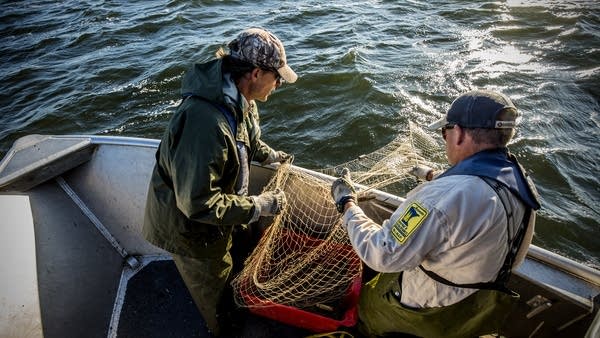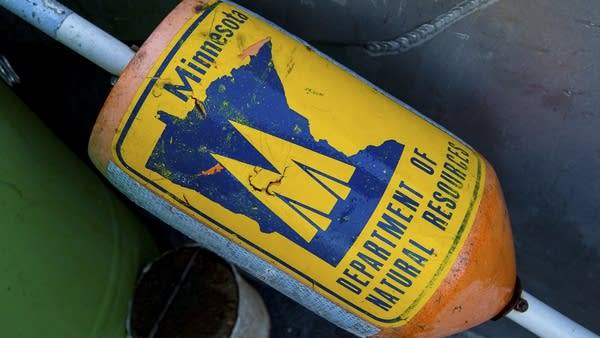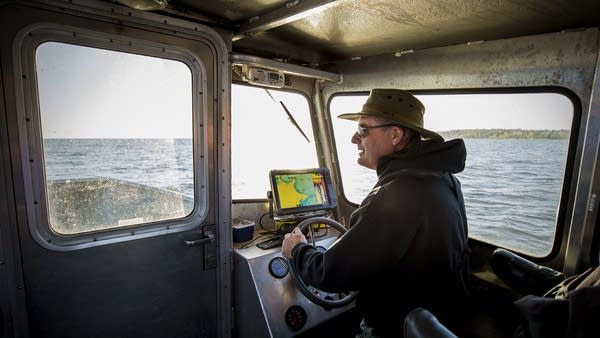Under locals' scrutiny, DNR nets for Mille Lacs walleye health

Go Deeper.
Create an account or log in to save stories.
Like this?
Thanks for liking this story! We have added it to a list of your favorite stories.
On the choppy waters of Mille Lacs Lake, Tom Jones steers a 26-foot aluminum boat within arm's reach of a bright orange buoy.
Greg Berg and Kris Nissen lean over the side and start hauling in a 250-foot gill net hand over hand. The net has holes of different sizes in the mesh designed to catch different types of fish.
"This is probably one of the heavier nets we've had this year so far," said Berg, an assistant area fisheries supervisor with the Department of Natural Resources, as he pulls it in. "A lot of it's tullibees. Some pretty nice walleye in there too."
The gill netting is part of the DNR's annual fall assessment on Mille Lacs Lake, which has been underway since early September.
Turn Up Your Support
MPR News helps you turn down the noise and build shared understanding. Turn up your support for this public resource and keep trusted journalism accessible to all.

"They catch all the species in the lake pretty well, which is kind of the point, is to get a picture of the forage fish and game fish and everything that's out there," Berg said.
With tighter walleye regulations on Mille Lacs the last few years, the DNR's work is under intense scrutiny. The data collected during this survey will be used to determine next year's safe harvest limits. It also will help provide clues for what's causing the lake's walleye population to decline.
Jones, treaty coordinator for the DNR's northeast region, has been surveying Mille Lacs for almost 20 years. In that time, he's seen lots of changes.

"We've seen the walleye go from real big heavy walleye," he said. "And now there tend to be skinny walleye, which is why the bite is so good. The walleye are hungry. So even though there's fewer walleye, because they're so hungry, anglers are finding them easier to catch."
Jones many factors could have caused the lake's walleye to decline over the past decade.
The water is clearer, and there are fewer small forage fish for the walleye to eat, he said. More recently, the lake has become infested with invasive species like zebra mussels and spiny waterfleas, which compete for the same resources down the food chain.
There's also been an increase in smallmouth bass, possibly due to climate change, Jones said.

"The warmer water favors warmer water species," he said. "In Mille Lacs, we've seen an increase in bass, a decrease in tullibee, a decrease in burbot. Burbot are almost gone from Mille Lacs."
But area business owners have been skeptical of the DNR's findings, saying the walleye fishing on Mille Lacs is as good as it's been in years.
Dean Hanson, owner of Agate Bay Resort and co-chair of the Mille Lacs Fisheries Advisory Committee, said some of the gill net locations were picked 40 years ago ‐ before GPS technology.
Since then, the DNR has added more nets in deeper water offshore. But Hanson said there are still too many in the shallows where there aren't walleye anymore.
"They're not going to show that they found many fish," he said. "But that's not going to convince me that there's no walleyes in the lake. I just see too many healthy fish out there for that to be in the case."
In response to such skepticism, this year outside experts will review the DNR's science and management of Mille Lacs. DNR officials hope that will help rebuild trust.
Jones said the DNR is aware of the criticism. But he said the data collected from the gill nets matches an independent population estimate conducted in the spring.

"That's one of the reasons why we keep believing our gill nets, is because we have other data that corroborates what the gill nets are finding," Jones said.
After the nets are collected, they are hauled to the DNR's Aitkin office, where the work continues.
Nissen, an assistant fisheries technician, analyzes a fish laid out on a board in front of him. He measures and weighs it, determines its sex and counts the number of eggs.
Nissen takes a tiny sample of its scales, then he saws off the fish's head and takes out tiny ear bones called otoliths. Like tree rings, they can be used to figure out how old the fish is. Then he cuts open the fish's stomach to see what it's been eating.
"Three of this year's perch, it looks like," Nissen said.

Large lake specialist Eric Jensen said walleye tend to eat perch if they're available. If not, they'll start eating younger walleye.
"That's probably where we're having the trouble with juvenile survival is that predation, when there's not enough forage available for the larger fish," Jensen said.
What has DNR scientists worried, Jensen said, is that only the 2013 class of walleye is above the median size.
"We don't want to simply open up harvest on them and then deplete that year class down so much that all of the sudden, we don't have adequate spawning biomass out there and nothing coming up behind it," Jensen said.
DNR staffers collect other measurements from the lake, including water temperature, clarity and the amount of zooplankton. They also use gill netting of forage fish and electrofishing to get a clearer picture of the health of the lake's fish.
All the data goes into a model that estimates how many walleye are in the lake. But no matter the results, business owners like Dean Hanson may not be convinced.
"We know what we see on a daily basis, and we don't believe the numbers," Hanson said. "So that's always been an impasse for us is they purely want to go what their statistics show. And we say, look at what we see every single day. It doesn't jive with what your statistics show."



